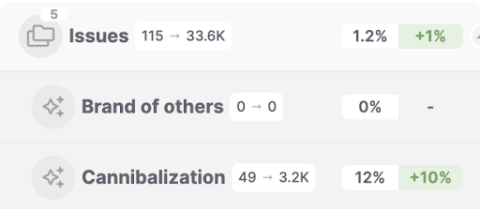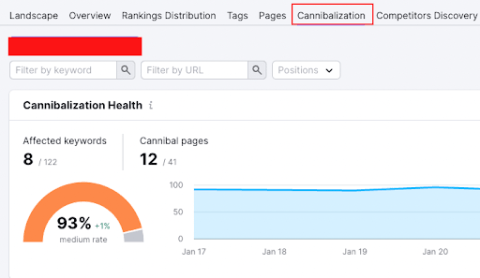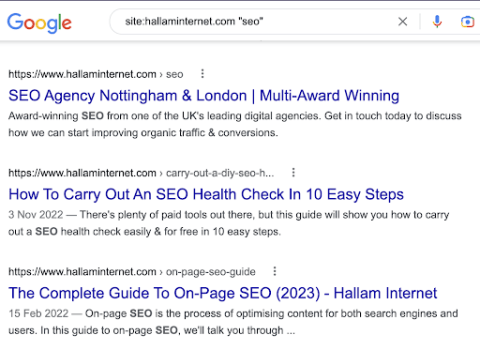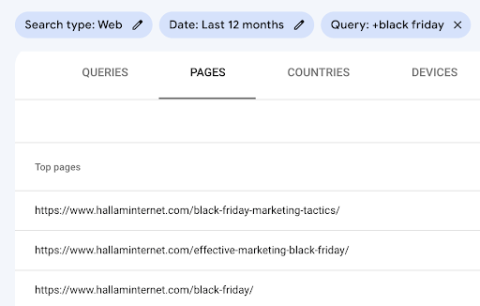Keyword cannibalisation occurs when you’ve optimised two pages for the same or very similar keyword. You might’ve done this on purpose or by accident, but either way it’ll cause you issues when it comes to ranking for the term as you’re sending conflicting signals to search engines over which URL you want to rank and the pages will end up competing with each other.
Google is forced to choose between which URL it ranks higher on search results, so it might rank the wrong page higher or rank both URLs in a lower position than a competitor’s URL that has stronger relevant signals.
Cleaning up SEO keyword cannibalisation can be done as part of a content audit, and in our experience, it generally boosts ranking efforts.
When is keyword cannibalisation a problem?
If you’ve deliberately optimised several pages for the same target keyword with the hope that getting multiple pages to rank will boost your chances of gaining visibility for that term, it’s simply not going to work. Google generally won’t show more than one listing from the same domain, unless doing so is going to be particularly beneficial.
It could also happen unintentionally – you might have multiple articles on a similar, but not identical topic, and these might end up ranking for the same or similar keywords. It’s important that each URL focuses on one specific topic, and whilst it’s fine for new pages to branch off into subtopics, the primary keyword focus of each of your URLs should be distinct.
It’s worth noting that keyword cannibalisation isn’t always a problem. URLs are naturally going to start ranking for lots of different terms, and some of these are likely to overlap across your website – it’s only an issue it starts impacting performance. For example, if you notice multiple URLs targeting exactly the same keyword and neither page is ranking well, you might be able to improve the visibility and traffic of each by consolidating these pages. But, if you have a page optimised for a target keyword that’s ranking well and gaining traffic, and then notice a different URL start to gain visibility for the same or a similar term lower down in the search results, it’s probably best to just leave it alone.
Identifying keyword cannibalisation
Many rank tracking tools will highlight when multiple URLs are competing for the same keyword. In SEOMonitor you can filter your tracked keywords by ‘Issues’ to identify where cannibalisation is occurring:
Likewise, if you’re tracking keywords in Semrush there’s a specific cannibalization tab:

But don’t worry if you’re not tracking keywords in a paid tool. There’s free ways of identifying cannibalisation too:
A site: search
Using a site: search can be fairly useful in this sense. Pop your domain name and target keyword into Google like this:
site:domainname.com “keyword”
This will enable you to see ranking URLs related to this term, such as:

Note that this doesn’t necessarily highlight a problem – as you can see in the above example, these are distinct pages related to SEO. But it might highlight a few pages you’d want to look into in more detail.
Google Search Console
If you search for a particular query in Google Search Console, you’re able to see all the URLs that are gaining impressions and clicks for that term. We’d expect to see impressions for a query across quite a large set of URLs, so that’s not a problem.
However, if you’re seeing more than one URL picking up clicks for a specific query, that certainly warrants further investigation. You’re potentially diluting your overall visibility for that term by forcing Google to choose which URL to rank highest.
How to fix keyword cannibalisation issues
If you’re working on a new website build, internal keyword cannibalisation issues can be avoided by creating a keyword map which assigns every page a target keyword. This builds in good SEO from the start and will help minimise issues in the future.
But if that’s not been the case, there are three methods that can fix any keyword cannibalisation problems.
1. Consolidate your content
Think about quality over quality. It’s better to consolidate relevance and ranking signals in one URL than it is to dilute that across multiple similar pages – this clearly signposts to Google which URL we want to rank for this core keyword. For example, when carrying out a content audit, we noticed that we had three separate URLs gaining impressions for the term ‘black friday’.Written years apart from each other, each was a blog on the same topic of Black Friday marketing tactics. In this case, the cannibalisation was resolved by merging any useful content into the strongest, most recent URL /black-friday-marketing-tactics, and 301 redirecting the other two into this URL.
 When carrying out a content audit and identifying multiple URLs on the same or similar topic, it’s worth consolidating the content into one URL and redirecting the weaker pages (measured by lower clicks/impressions/rankings) into this URL.
When carrying out a content audit and identifying multiple URLs on the same or similar topic, it’s worth consolidating the content into one URL and redirecting the weaker pages (measured by lower clicks/impressions/rankings) into this URL.
Before taking this action, remember that the URLs you’re redirecting may already rank for a number of other terms that could have some decent search volume.
Therefore, it’s best to weigh up whether you might be losing any valuable rankings by consolidating your content. Generally it’s only something you should do if the content or topic is very similar.
2. Using the noindex tag
In some instances, the noindex tag could be more appropriate. For instance, while working with a new client recently, I noticed in Google Search Console that multiple URLs were gaining impressions for what I’d suggested to be a primary target keyword. These URLs were paid landing pages that Google had been allowed to index, and there were several versions targeting exactly the same organic keyword which I wanted the client to rank higher for. In this case, consolidating the content into one URL wouldn’t have been appropriate, as those paid landing pages were driving traffic and revenue from their ad campaigns. But, they didn’t need to be accessible to Google, so we added a noindex tag on all the URLs we didn’t want to see ranking organically, clearing up confusion over which URL we wanted to rank and led to greater visibility.
3. Improve internal linking
Our final point sticks to the basis that you need to make things as easy as possible for Google for it to understand which URL you want to rank for a certain term. Another crucial step that will guide Google in the right direction is making sure you optimise internal linking and anchor text to point to the URL you want to rank for that query. So, when you have a target keyword for a page, make sure that internal links point to that page, ideally using that target keyword or a variation of it as the anchor text. And even more importantly, try to avoid using that target keyword in anchor text pointing to a different URL.
Takeaways
If you take away nothing else, at least takeaway these 5 points:
- Keyword cannibalisation is only an issue if it’s holding back organic performance
- This might be the case if you have multiple indexed URLs targeting the same keyword
- You can spot keyword cannibalisation in rank tracking tools, or by using Google Search Console or a site: search command
- It can be fixed by focusing on quality over quantity, and remembering to make which page you want to rank for a term as clear as possible for Google
- Methods for implementing this include consolidating and redirecting content to one URL, using the noindex tag and improving internal link signals.
If you’ve got further questions about keyword cannibalisation issues, get in touch with a member of our SEO team.



